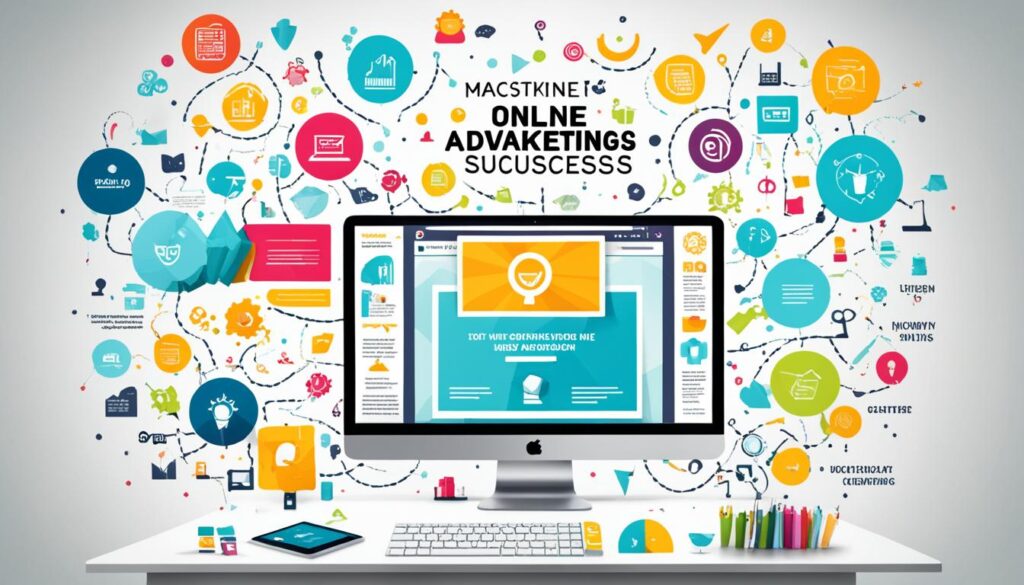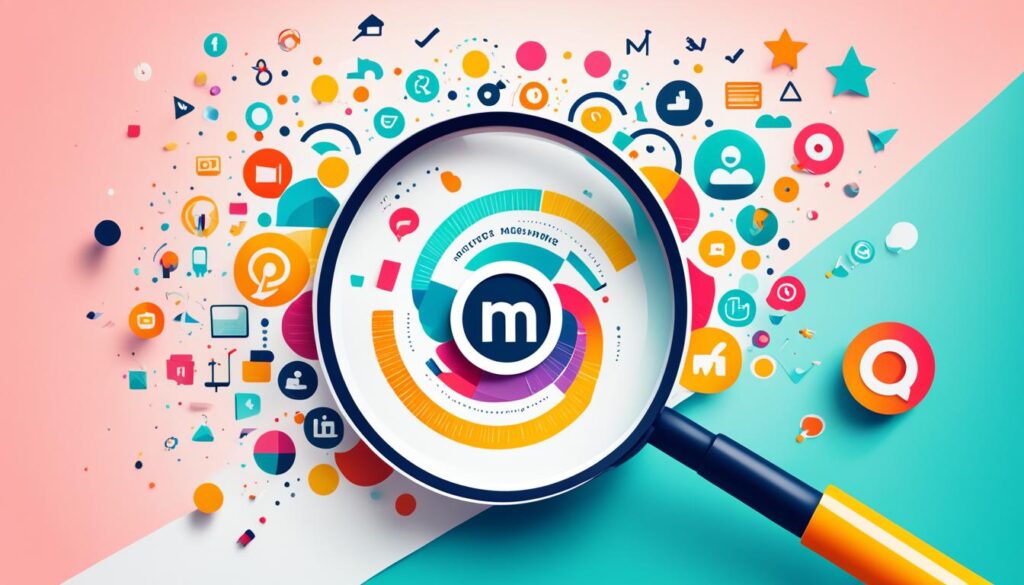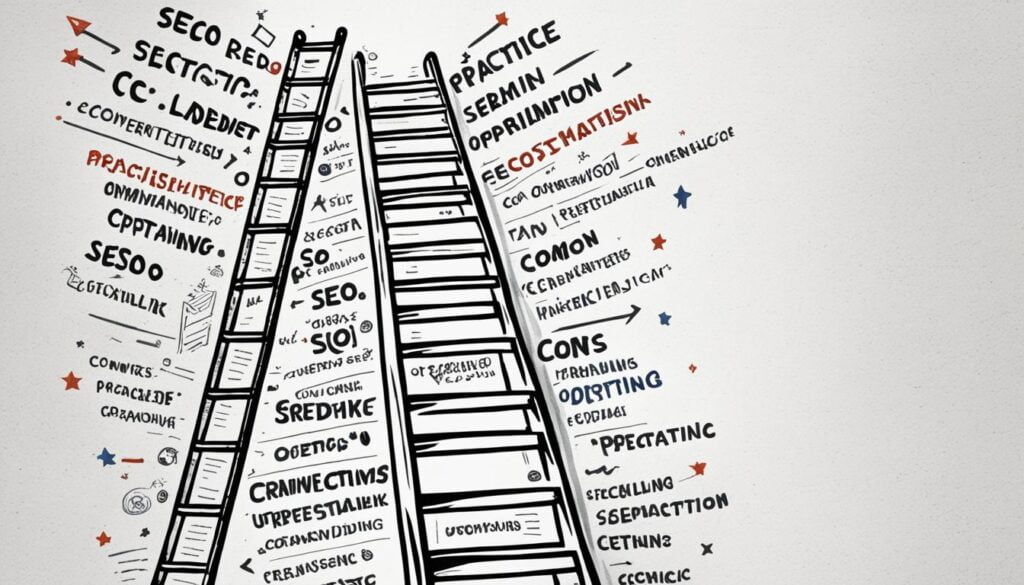Ever wondered why some brands do well online and others don’t? It’s all about how they use digital marketing. Today, using social media, websites, search engines, emails, and texts is key.
Digital marketing mixes traditional marketing goals with modern tech. It’s become vital for businesses. Since the internet began, digital marketing has grown a lot. It’s moved from simple webpages to complex campaigns that work really well.
By 2025, chatbots will handle 95% of customer service, showing how AI is becoming part of digital marketing1. Also, 54% of people like to shop online, making a strong online presence important2. Videos have a big impact too. 77% of consumers bought software or apps after watching a brand’s video1.
Key Takeaways
- Digital marketing seamlessly combines traditional marketing goals with modern digital technologies.
- By 2025, chatbots are expected to handle 95% of customer service interactions1.
- 54% of consumers express a preference for online shopping2.
- Video marketing influences 77% of people to purchase software or apps after viewing a brand’s video1.
- Effective digital marketing strategies drive awareness, engagement, and sales through a mix of channels.
Introduction to Digital Marketing
Digital marketing is all about using the internet and electronic devices to share marketing messages. It aims to reach audiences in a modern way, while holding onto traditional marketing goals. This type of marketing uses the web to achieve its objectives.
What is Digital Marketing?
This marketing covers tactics and strategies to reach people online. It uses social media, search engines, websites, email, and apps. The goal is to connect with consumers, boost engagement, and encourage them to take action through online interactions.
Evolution of Digital Marketing
Digital marketing’s story started with the World Wide Web in 1989. This was the beginning of today’s digital world. Companies first got online with websites. Then, email opened new communication ways. Social media required marketers to learn new strategies as platforms changed.
The ad world online has grown, with a 16.2% bump in 2022, hitting $491.70 billion in 20213. Over half of ad spending is now on mobile3. Also, 87% of marketers use video in their campaigns3. Staying updated with digital marketing trends is crucial.
Digital marketing is far-reaching; most Americans go online daily. Some are online multiple times a day, and 26% are almost always online4. With many on mobile internet almost all the time4, marketers need to create content that is engaging and useful4.
Why Digital Marketing is Essential
Digital marketing is crucial for businesses wanting to be noticed in a busy market. It reaches over 5.16 billion internet users globally as of January 2023. This offers access to many potential customers5. It’s key for building your brand and getting people to interact with you.
Reach and Engagement
Digital marketing shines in its reach and interaction. It helps businesses get 24 million leads and over 7.14 million calls from clients6. Platforms like social media and email keep your audience updated and engaged in real-time.
Cost-Effectiveness

Email marketing stands out for its cost-effectiveness, boasting a 3,600% average return on investment5. Digital campaigns bring in $6 billion in revenue, showing high returns6. This lets smaller companies compete with bigger ones by using digital strategies.
Targeted Advertising
Targeted advertising makes digital marketing powerful. It allows precise reaching of audiences. PPC ads, for instance, can boost brand awareness by up to 80%6. Tailoring messages to people’s likes increases chances of making a sale.
SEO marketing also offers a high ROI, translating to 2,200% or a ratio of 22:15. Targeted campaigns get better outcomes and improved performance numbers.
Types of Digital Marketing
Digital marketing today offers various ways to connect with your target audience. Each type has its own perks and potential gains.
Content Marketing
Content marketing is key in drawing in and keeping the audience’s attention. It uses blogs, infographics, and videos to offer valuable content. This content is made to get consumers to act.
Social Media Marketing
Social media marketing uses sites like Facebook, Instagram, and LinkedIn. It aims to promote brands and talk to customers. Pew Research says Instagram hits the mark with 25 to 29-year-olds, while Facebook is popular among those 65 and up7.

Email Marketing
Email marketing is highly cost-effective, returning about $40 for each dollar spent7. Using strategies, such as personalization and urgency, improves its success8.
This marketing form keeps proving itself as a direct way to communicate with your audience9.
SEO
SEO works to boost organic traffic by making websites more visible on search engines. But, it needs updates to keep up with Google’s changes7. Tools like Google Analytics help understand keywords and what users want8.
PPC Advertising
PPC advertising lets businesses put ads on search engines and social media, paying only when clicked. It’s very adjustable. Combining it with other digital marketing can bring great results9. SEM ad costs vary with each click7.
Mobile Marketing
Mobile marketing targets smartphone users via SMS, apps, and mobile-friendly content. It’s effective because it can tailor offerings based on location and preferences8. Remarkably, 76% of U.S. adults have bought items using their phones9. Also, 27% of people globally use mobile voice search, underscoring the value of quick and mobile-ready marketing tactics7.
Building an Effective Digital Marketing Strategy
Creating a good digital marketing plan requires planning and knowing the key elements that lead to success. It’s crucial to begin with clear goals and a solid understanding of your target audience. Then, pick the best digital marketing channels to reach them.
Setting Clear Objectives
Starting with SMART goals is key. This means your goals should be Specific, Measurable, Achievable, Relevant, and Time-bound. For example, aiming for a 20% rise in social media followers in the next three months is a clear goal10. By setting such goals, you make sure all marketing actions help reach these outcomes.
Understanding Your Audience
Crafting detailed buyer personas and looking into their demographics, behaviors, and likes is how you start understanding your audience. A structured approach, like a 10-step guide for making a customer profile, works well10. Using tools like Facebook Audience Insights and Google Trends, you can get to know your audience’s demographics and behaviors better11. This deep knowledge lets a digital marketing team customize their strategies effectively.

Choosing the Right Channels
It’s crucial to pick the right channels to share your content where it fits best. Major digital marketing channels include social media platforms such as Facebook, Instagram, Twitter, and LinkedIn12. Each platform has unique advantages. Choosing channels wisely based on your strategy can significantly boost your marketing results11. By matching your content with where your audience is online, you increase your chances of engaging with them and getting better results.
| Objectives | Steps | Channels |
|---|---|---|
| 20% increase in social media following | Create a customer profile in 10 steps, Use SMART goals | Facebook, Instagram, Twitter, LinkedIn |
| Clear goals, strategies, objectives, and tactics | Use GSOT strategy framework | Social Media, Email, SEO, PPC, Influencer Marketing |
Top Digital Marketing Channels
Understanding the top digital marketing channels is key in today’s fast-paced world. Social media, email campaigns, and search engines are top tools. These platforms help increase your strategy’s success.
Social Media Platforms
Social media is a powerful tool for getting your brand seen and talking to customers. It reaches 72% of U.S. adults with at least one account13. You can use posts, videos, and stories to keep in touch with your audience.
According to HubSpot, 81% of marketers use multiple channels including social media14. This makes social media key for reaching more people.

Email Campaigns
Emails are great for direct communication and growing customer relationships. For each dollar spent, businesses can earn $36 back, making it very profitable13. About one in three marketers use email to reach future customers, showing its importance14.
Using personalized emails and grouping customers by interest can make your messages hit closer to home. This approach makes sure you connect with your audience effectively.
Search Engines
For increasing online presence and traffic, search engines are essential. Using SEO to optimize websites and create strong backlinks improves rankings15. Also, 74% of businesses see more website visits and leads through PPC ads13.
Combining SEO with paid ads offers complete and effective digital marketing. This strategy helps companies stand out online.
Search Engine Optimization (SEO) Best Practices
It’s crucial to understand and use effective SEO strategies. This boosts your site’s visibility and the number of visitors. SEO involves on-page, off-page, and technical parts. This makes sure your website is fully optimized for search engines.
On-Page SEO
On-Page SEO makes your website’s content and layout better. It includes adding the main keyword in crucial places like the title, meta description, and content16. Also, matching your content with what users are searching for increases relevance and user interest16.

Off-Page SEO
Off-Page SEO works on increasing your site’s authority through backlinks. A good structure of internal links helps users and search engines find their way around your site16. Building links from reputable sites is key to success in SEO17.
Technical SEO
Technical SEO improves your site’s rankings by optimizing technical features. Making images smaller and quicker to load can help. Formats like WebP are great for this16. Your site should work well on phones, and loading quickly is a must. Tools like Semrush’s Site Audit or Google’s PageSpeed Insights can help with this16.
Technical SEO also involves improving URLs, making navigation easy, and using structured data. All these steps help make your website perform better17.
Following these SEO tips and creating a strong SEO plan can put you at the top of search engine results. This leads to more visitors and boosts your online presence and credibility.
Maximizing ROI with PPC Advertising
PPC advertising is key for getting quick traffic to your site through well-placed ads. It’s not just about buying clicks. It’s about making each click work towards achieving your marketing objectives. Using Google Analytics helps marketers track and tweak campaign performance effectively18.
Understanding PPC
With PPC, you pay for ad spots in search engine sponsored links. Without careful planning, this method can be expensive19. But, if done right, PPC can bring in targeted traffic and leads quickly19. Retargeting strategies boost ROI by drawing back visitors who previously didn’t convert18.
Bidding Strategies
Successful bidding means having clear goals and choosing the right keywords. This manages costs and increases campaign effectiveness19. Focusing on popular, relevant keywords helps ads find the intended audience. This increases your chance of getting conversions18. Always optimize by watching metrics such as click-through rates and conversion rates. This boosts your performance19.
Ad Copy and Extensions
Making your ad copy compelling and using ad extensions can lift your click rates. Good descriptions and catchy headlines improve your ads19. Including helpful ad extensions makes your ads stand out more. This leads to better click rates and more conversions19.
Tracking is crucial in PPC campaigns. It’s the foundation for measuring success and finding what needs improvement18. With the right strategy and adjustments, PPC is a strong way to get good ROI. It draws in targeted traffic and boosts leads and sales18. Remember, attracting targeted traffic not only brings immediate results. It also builds trust with your audience, leading to strong brand recognition and increased sales over time18.
The Power of Social Media Marketing
Social media marketing uses platforms like Facebook, Instagram, and TikTok to boost brands. Over 4.76 billion people used social media in 2022. This shows the big chance for businesses to reach people through engaging online content20.
Choosing the Right Platforms
Finding the best platforms is key for strong social media marketing. It matters to know where your audience spends time. For example, around 3 billion folks are on Facebook, with most visiting daily21. Facebook is great for reaching many people. TikTok, known for its high engagement, is perfect for grabbing attention fast21.
Creating Engaging Content
Making content that grabs and keeps people’s interest is vital. Content that people want to share boosts engagement, draws new customers, and builds loyalty20. Nearly half of users find new products through ads on social media. And 40% find them through regular posts from brands21.
Analyzing Performance
Measuring success in social media marketing is crucial. Key things to watch are how often people interact, follower growth, and how many turn into customers. Sprout Social suggests keeping an eye on impressions, reach, share of voice, and how quickly you respond to build a better social media plan20. Engaging with users helps answer their questions, share interesting content, and build connections. This can lead to loyal customers and more sales21.
Creating a Successful Content Marketing Strategy
To build a winning content marketing strategy, start with a plan. Identify your main topics, create and share your content wisely, and check if it works. By doing so, companies can improve their online marketing. This leads to better engagement and more success.
Identifying Content Pillars
At the beginning, find your content pillars. These are the big topics important to your audience. Knowing who your audience is, what they need, and what they like to see helps. It helps you choose topics that fit and support your business aims. A detailed plan for content marketing leads to better success. It keeps content in line with business goals22.
Content Creation and Distribution
Once you know your pillars, it’s time for creating and sharing content. Create content that teaches, entertains, or inspires your audience23. This could be blogs, videos, podcasts, eBooks, or infographics. Use tools like Semrush to find good topics and make your content better22. Planning and using a content calendar helps you stay organized. It makes it easier to carry out your content strategy22.
Measuring Content Effectiveness
It’s important to see if your content is working. Look at how much traffic you get, how people interact, and if it leads to sales22. Set clear goals, like increasing revenue or getting more signups23. This helps you track how well your content strategy is doing. Doing content checks can show where to improve or change to better meet your audience’s needs24.
Leveraging Email Marketing
Email marketing remains a powerful way for companies to communicate directly with their audience. To build email lists, it’s vital to offer valuable content or rewards for signing up. This approach greatly increases your reach.
Building Your Email List
At the heart of effective email marketing is the creation of strong email lists. By offering incentives like discounts or special content, you can motivate people to join your list. Turning existing content into captivating emails also attracts new followers, keeping your messages interesting.25
Crafting Compelling Emails
Writing engaging emails is crucial to grab the attention of your readers and spark action. Personalizing emails with the recipient’s name and catering to their interests can lead to better open rates and more conversions.25 This method improves your relationship with your audience and strengthens their loyalty to your brand.
Segmentation and Personalization
Segmenting your email list and personalizing messages are key to making your email marketing more powerful. By dividing your list based on customer interests and actions, you can send messages that truly matter to them. This approach increases both engagement and sales.26
It’s also crucial to monitor important metrics like how many people open your emails and click on links. This information helps you make your email campaigns even better over time.25
Mobile Marketing Techniques
Mobile marketing uses different ways to connect with customers on their phones and tablets. This ensures brands can effectively catch the attention of their audience.
SMS Marketing
SMS marketing is a strong method. It uses the high open rates of texts to send quick promotions to consumers. By adopting SMS marketing, companies can boost leads and sales effectively27. But, it’s important to get consent before sending SMS to avoid unwanted marketing27.
App-Based Marketing
Marketing through apps taps into the growing number of mobile app users. For example, Domino’s Pizza (UK) has nearly eight million active app users28. This results in 75.2% of its online sales. Ads in apps or optimizing app store listings, along with AI for marketing, can push targeted content27. Data.ai shows that 70% of mobile time is on social, photo, and video apps. Marketers use this to boost engagement28.
Mobile-Friendly Content
It’s key to make content mobile-friendly. Brands need to adjust their marketing for easy viewing on mobile devices. This drives steady engagement27. Over half of web traffic comes from mobile users. This highlights the need for mobile SEO to be more visible online28.
Personalized ads and content with interactive elements like games improve engagement. This keeps the audience interested longer28. Offering personalized experiences meets the expectations of 71% of consumers28.
Combining these strategies in mobile marketing boosts engagement and outcomes. It takes advantage of mobile features and its large user base.
Conclusion
Using many strategies is key to digital marketing success. It uses different strategies to boost engagement and sales. This includes social media, search engines, and email. These channels help reach a lot of people, giving a great chance to connect with a varied audience29.
Digital marketing makes sure your ads reach the right folks. It looks at their interests, where they are, and what they do. This way of targeting helps get more out of your money. You can track how well your ads do and learn what works best29. Plus, it’s cheaper to start a digital ad campaign than traditional ones29.
New trends like AI, Marketing Automation, and VR are changing digital marketing30. AI chatbots and analytics make strategies smarter. Marketing automation saves time by handling repetitive tasks30. It’s important to keep up with these tech changes to stay ahead in digital marketing30. By following these tips, you can create effective online strategies that last.
FAQ
What is Digital Marketing?
Digital marketing is a way to promote stuff online. It uses social media, websites, search engines, email, and texting. These tools help boost awareness, engagement, and sales.
How has Digital Marketing evolved?
Since the web started in 1989, digital marketing has changed a lot. It has expanded through business websites, email, and social media sites like Facebook, Instagram, and TikTok.
Why is Digital Marketing essential for businesses?
Digital marketing helps businesses achieve their goals in today’s online world. It’s wide-reaching, affordable, and targets specific groups. It helps companies stand out and reach people who are always online.
What types of Digital Podizel Marketing services are there?
The main kinds include content marketing, social media marketing, email marketing, SEO, PPC ads, and mobile marketing.
How do you set clear objectives in a digital marketing strategy?
To set clear goals, first figure out what your business wants to achieve with digital marketing. This makes your strategy focused and guides all marketing actions.
Why is understanding your audience important?
Knowing your audience lets you tailor your marketing. It’s about matching your message to their needs and habits. This increases engagement and the chances they’ll act.
How do you choose the right digital marketing channels?
Choosing channels depends on where your audience hangs out online. You want your content to reach them well. Popular choices are social media, email, and search engines.
What are SEO best practices?
Good SEO means optimizing content, earning backlinks to boost your site’s authority, and improving speed and mobile-friendliness. This helps more people find your website.
How does PPC advertising work?
PPC is when you pay each time someone clicks your ad. It gets immediate traffic through ads on search engines and social media. Using the right keywords and ad copy is key.
What are the benefits of social media marketing?
Social media marketing increases your brand’s visibility on platforms like Facebook and Instagram. It engages customers and provides data to improve your marketing.
How do you create an effective content marketing strategy?
A strong content strategy focuses on key topics, creating useful content, and tracking its success. You measure by looking at traffic, engagement, and conversion rates.
What are the key elements of a successful email marketing campaign?
Successful email marketing involves getting people to sign up, sending interesting and personal emails, and targeting messages to specific viewer interests and actions.
How can mobile marketing enhance your digital strategy?
Mobile marketing connects with people on their phones. It uses SMS, apps, and mobile-friendly content. This ensures your message is easy to access on any device.
Source Links
- https://optinmonster.com/digital-marketing-best-practices/
- https://webfx.com/digital-marketing/learn/digital-marketing-strategies/
- https://www.mygreatlearning.com/blog/introduction-to-digital-marketing/
- https://mailchimp.com/marketing-glossary/digital-marketing/
- https://www.futurelearn.com/blog/why-is-digital-marketing-important-for-business
- https://www.webfx.com/blog/marketing/importance-of-digital-marketing/
- https://www.simplilearn.com/types-of-digital-marketing-article
- https://www.snhu.edu/about-us/newsroom/business/types-of-digital-marketing
- https://www.investopedia.com/terms/d/digital-marketing.asp
- https://blog.hubspot.com/marketing/digital-strategy-guide
- https://www.forbes.com/sites/forbescoachescouncil/2021/02/25/how-to-create-a-digital-marketing-strategy-eight-steps-to-laser-focus-your-plan/
- https://www.linkedin.com/pulse/crafting-effective-digital-marketing-strategy-guide-nicole-booysen-cljpf
- https://www.springboard.com/blog/business-and-marketing/digital-marketing-channels/
- https://blog.hubspot.com/marketing/marketing-channels
- https://www.semrush.com/blog/digital-marketing-channels/
- https://www.semrush.com/blog/seo-best-practices/
- https://searchengineland.com/guide/what-is-seo
- https://strategicemarketing.com/7-effective-ways-to-maximize-roi-of-your-ppc-campaigns/
- https://qcmarketing.com/maximizing-roi-ppc-advertising/
- https://www.investopedia.com/terms/s/social-media-marketing-smm.asp
- https://online.stu.edu/degrees/business/mba/marketing/the-power-of-social-media/
- https://www.semrush.com/blog/content-marketing-strategy-guide/
- https://optinmonster.com/how-to-create-a-successful-content-marketing-strategy-in-8-simple-steps/
- https://blog.hubspot.com/marketing/content-marketing-plan
- https://solutions.technologyadvice.com/blog/how-to-combine-email-marketing-and-digital-ads/
- https://www.buzzboard.ai/leveraging-email-marketing-tools-for-successful-communication-with-local-businesses/
- https://www.forbes.com/sites/forbescommunicationscouncil/2022/09/19/11-effective-mobile-marketing-techniques-that-can-drive-leads-and-sales/
- https://www.semrush.com/blog/mobile-marketing/
- https://www.sunmediamarketing.com/digital-marketing/conclusion-of-digital-marketing/
- https://cursa.app/en/page/conclusion-what-to-expect-from-digital-marketing-in-the-future
